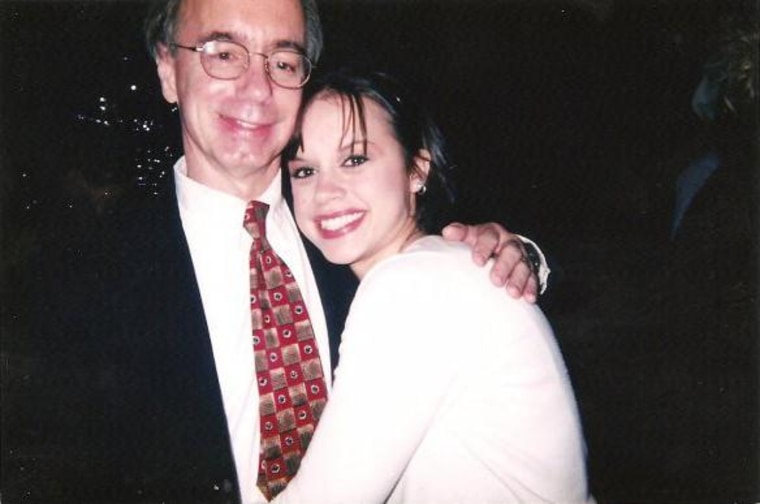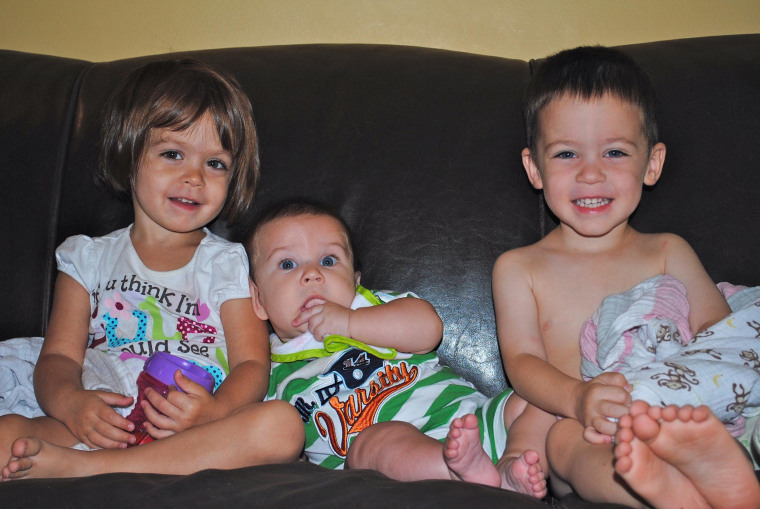A Tennessee woman with a fatal inherited disorder has three disease-free children — toddler twins and a 9-month-old — thanks to the new use of a growing procedure that lets parents pick healthy babies in a Petri dish.
Amanda Kalinsky, 30, of Nashville, learned four years ago that she has a genetic mutation that causes Gertsmann-Straussler-Scheinker Disease, or GSS, a rare neurodegenerative condition that causes symptoms that start in mid-life and inevitably lead to death.
“I just screamed. I became primal. You just shut down,” said Kalinsky, recalling the moment she learned she had the ailment that killed her father and grandfather. “And then I said, ‘Well, what are we going to do about this?’”
There's no treatment, no cure, and people who are born with the mutated gene always develop the syndrome.
Kalinksy and her husband, Bradley, 33, knew they wanted to have biological children, but not if it meant that the babies could inherit the faulty gene mutation. That’s when doctors told them about preimplantation genetic diagnosis, or PGD, a genetic screening technique used with in vitro fertilization, or IVF, to implant only healthy embryos in a woman’s uterus.
“I just screamed. I became primal. You just shut down."
Using the procedure, they became parents of Ava and Cole, their 3-year-old twins, followed by Tatum, 9 months.
“I wanted to have them quickly and early so that they can have their mom as long as possible and I can have my children as long as possible,” said Kalinsky, whose case is described in an article by Dr. Alice Uflacker of Duke University and colleagues published Monday in the American Medical Association journal JAMA Neurology.
Kalinsky's doctors used IVF technology to retrieve 14 eggs, including 12 that were fertilized. Testing revealed that six of the embryos carried the GSS mutation and they were destroyed, a process that she said was “one of the hardest parts of this.”
Five of embryos were both disease-free and viable, and two of those were implanted immediately, leading to her first successful pregnancy. Three others were frozen for later use. When the twins were 2, Kalinsky became pregnant again.
“We are planning on most likely we will have a fourth child and see what happens,” she said.

Developed in 1990 in Britain, PGD is more widely used in Europe and has been gaining ground in the U.S. in the past decade, though it’s still not widely known, even among physicians, said Dr. Ilan Tur-Kapsa of the Institute for Human Reproduction in Chicago. He’s performed about 1,500 PGD procedures, including Kalinsky’s, and helped Duke University researchers write the report about Kalinsky’s case.
“We are not saying that everybody has to do PGD by tomorrow,” he said. “But we are saying that everybody should know about it.”
Overall, about 100,000 PGD cycles have been performed by more than 100 centers worldwide, according to the PGD International Society.
PGD uses genetic analysis to screen embryos for a growing list of conditions including cystic fibrosis, Sickle-cell disease, Huntington’s disease and the chromosome problem that causes Down syndrome. It’s used for tissue typing to conceive “savior siblings” who can donate bone marrow to a sick brother or sister.
And it can be used to choose gender and other non-medical characteristics, which makes PGD controversial in some circles, said Art Caplan, director of the division of medical ethics at NYU Langone Medical Center.
“The real ethical issue is not embryo creation to avoid severe diseases, but where to draw the line as genetic advances create the chance to use embryo pre-selection to pursue better or ‘perfect’ babies,” he said.
Tur-Kaspa said that the specter of eugenics, or selective breeding of humans, often obscures practical, real-world issues for families who hope only to have healthy children.
“It’s a very gradual disease. It just gradually takes your life.”
In Kalinsky’s case, this was the first time that PGD has been used for GSS, which is a brain disorder similar to Creutzfeldt-Jakob disease, or CJD. Both are rare, degenerative diseases that destroy the brain, causing difficulties with movement, speech, swallowing and thinking, eventually leading to death.
Kalinsky represents the sixth generation of her family to have GSS. Her dad was diagnosed at age 52 and died at 58 in 2010.
“For six years, he was ill,” she said. “It’s a very gradual disease. It just gradually takes your life.”
If the disease progresses like it did in her father, Kalinsky might be 50 when she starts showing symptoms. She has a brother who was tested and doesn’t have the genetic mutation and a sister who hasn’t decided whether to be tested. It’s possible that the disease symptoms could begin earlier, a thought that haunts Kalinsky daily, she said.
“I’ll trip over something and it will be, ‘Oh, god, is it starting?’” she said. “I wonder remember something like I should. That’s a repercussion of getting myself tested.”
But she said she would rather know than not know, and she’d rather pursue a normal, full life than wait for the fatal disease to strike. Choosing to have children despite having GSS is a way of fighting back, said Kalinsky, a hospice nurse who has also worked with trauma victims.
“There is hope for a cure,” she said. “I want people to know that just because life hands you something like this, it doesn’t mean that life is over for you. I want people to know that there are options. All it takes is a little bit of stubbornness and a little bit of research to get something done.”
